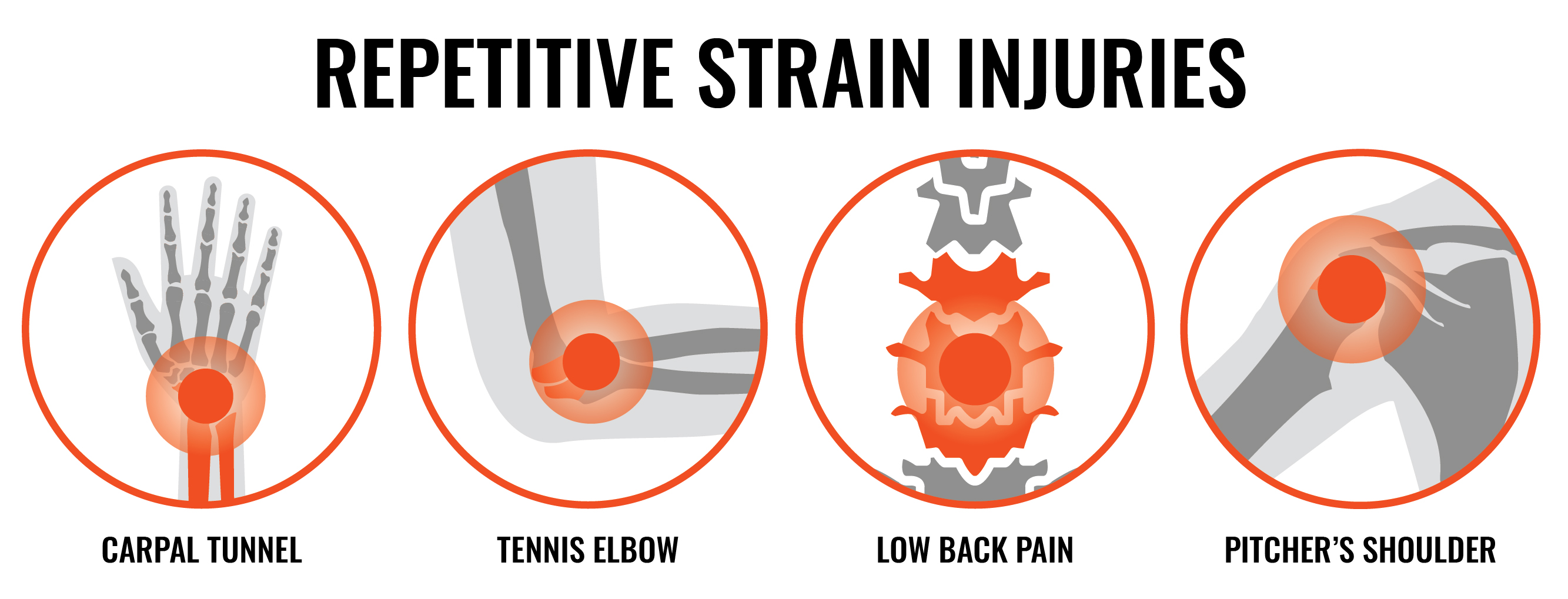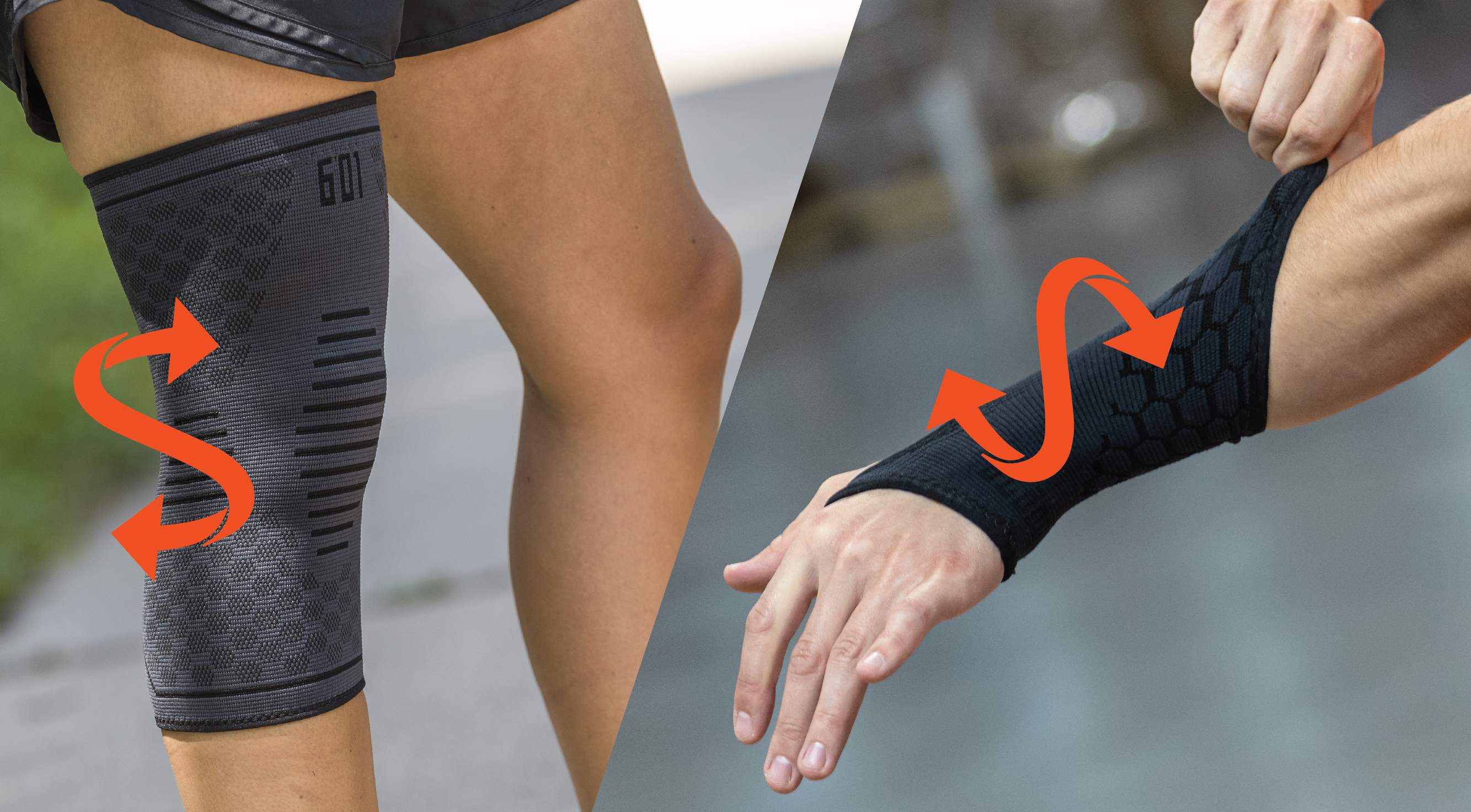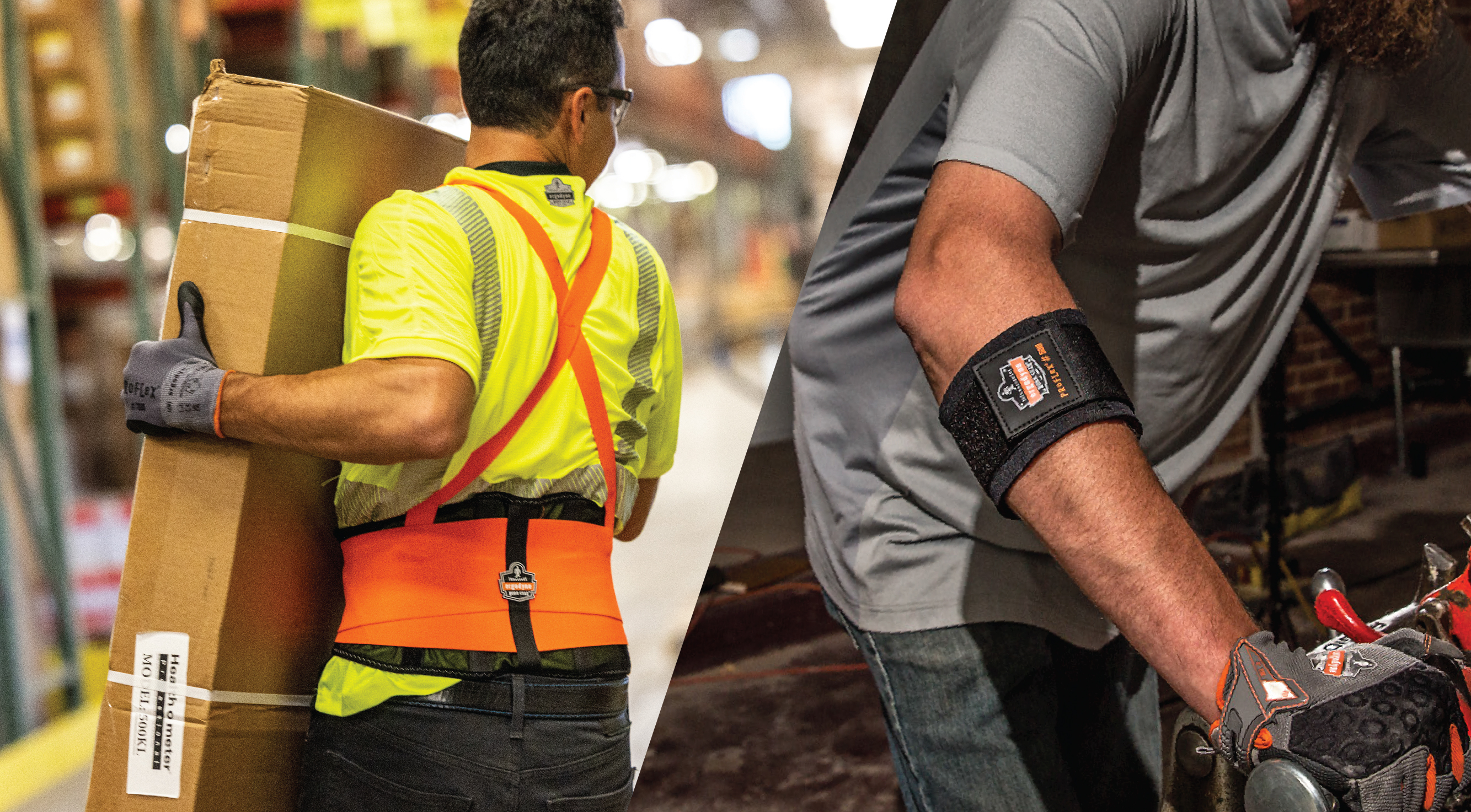Repetitive Strain Injuries in the Workplace: Types, Causes and Prevention

Let’s talk about the unspoken bane of office life and physical labor: Repetitive Strain Injuries (RSIs). Yes, those aches and pains that creep up from nowhere and stick around like an unwanted house guest. Whether it’s the infamous carpal tunnel syndrome from your marathon typing sessions or the dreaded low back pain from lifting heavy boxes, here’s how you can show them the door.

Understanding Repetitive Strain Injuries:
RSIs—also known as Musculoskeletal Disorders (MSDs) or ergonomic injuries—can range from merely annoying to seriously debilitating. They include favorites such as:
- Carpal Tunnel Syndrome: Brought on when the median nerve in your wrist gets squeezed, causing pain, tingling and numbness in your hand and fingers. It often happens from repetitive motions like typing or using tools.
- Tennis Elbow: Serving up pain and tenderness on the outside of the elbow, brought on by inflammation of over-used tendons.
- Low Back Pain: A classic that can ruin anyone's day/week/eternity. It can be caused by muscle strain, poor posture, heavy lifting or prolonged sitting.
- Pitcher’s Shoulder: Tossing a nasty curveball to your productivity with inflamed muscles and tendons around the shoulder from repetitive motions caused by things like constantly reaching over your head or an old school baseball coach who thinks pitch counts are for the weak.

They’re the kind of injuries that make you lose more than your patience—it could cost you your livelihood. In 2019, the Bureau of Labor Statistics dropped this little fun fact: 29% (that's 325,270 if you’re counting) of work-related injuries were due to those pesky work-related MSDs.
If you’re unlucky enough to get one, you’re looking at a median of 14 days “off”, while other work-related boo-boos only keep you home for nine. So, enjoy the extra couch time, we guess?
How Do Work-Related RSIs/MSDs Occur?
RSIs can arise from various workplace activities, particularly those involving:
- Repetitive Motion: Repeating the same movements can overwork the muscles and tendons.
- Overexertion: Lifting heavy items or pushing oneself beyond physical limits.
- Poor Posture: Maintaining an unnatural or awkward position while working.
- Prolonged Static Posture: Sitting or standing too long without changing positions.
Who is Affected by Repetitive Strain Injuries?
Anyone who performs tasks that involve heavy labor or sitting at a desk can be affected by RSIs. They are especially common in sectors like construction, manufacturing, and office environments where repetitive motion and static postures are part of daily routines.
But there’s good news from the Occupational Safety and Health Administration (OSHA): “Implementing ergonomic solutions can significantly reduce the incidence of repetitive motion injuries, ensuring a safer and healthier work environment.”
How to Prevent Repetitive Strain Injuries in the Workplace
Spotting the danger signs early in the workplace is crucial. It’s about observing the day-to-day operations and understanding where the risks lie.
Hierarchy of Controls - Getting Down to Brass Tacks
Cutting down on RSI risks isn’t rocket science, but it does need a strategy. Here’s the rundown:
- Elimination or Substitution: Ask yourself—do we really need to manually lift those heavy boxes, or is there a gadget that could do the heavy lifting? Maybe swap out those back-breaking tasks with something a bit more machine-friendly.
- Engineering Controls: Think about rearranging the dance floor (aka your workspace). Lower that shelf, bring in adjustable desks, or introduce tools that help rather than hinder. Make the workplace fit the worker, not the other way around.
- Administrative Controls: Rotate jobs, because variety is the spice of life and it also gives those tired muscles a break. Train everyone to recognize the signs of strain and teach them proper technique.
- Personal Protective Equipment (PPE): When all else fails, gear up. For example, back supports can be a lifeline, or at least a reminder to lift with those knees and not your back.
A Little Support Goes a Long Way
Speaking of PPE, one of the most helpful repeated actions you can take during your work week is wearing a support, wrap or sleeve again and again and…

Wraps, Sleeves and Supports for Knees and Wrists
Compression sleeves and supports are an often underutilized solution for bringing preventative support to hard-working joints on the job.
Some of the benefits include…
💪🏼 Stability: Aiding in the reduction of hyperextension or excessive movement that could lead to injuries.
🤗 Support: Beneficial when lifting heavy weight or performing repetitive tasks that put a lot of strain on the joint.
🔄 Compression: Helping reduce swelling and inflammation.
🚫 Injury Prevention: By providing support and stability, wraps, sleeves and supports can help prevent common injuries such as sprains, strains and tendonitis.
🙂 Reduce Discomfort: For individuals with existing issues, wraps, sleeves and supports can help alleviate discomfort during activities.
📈 Improved Performance: For example, wrist wraps can enhance grip strength and performance by providing a more secure and stable wrist position.
Back Supports
Back supports provide crucial lower back and abdominal support, promote good posture and serve as a reminder to use correct lifting techniques. However, it's important to understand that while back supports are excellent for preventing injuries, they do not increase strength or heal existing injuries (same for knee/wrist wraps and supports, for that matter).

For more on proper lifting techniques to pair with that back support, check out this blog post from the archives.
Stretch It Out
A runner would never run without stretching. A worker shouldn’t work without doing the same. And it’s especially easy to forget those smaller muscles in our fingers, hands and arms before you hammer them with 8-10 hours of lifting, typing, scanning or TikTok scrolling (we won’t tell).
While the evidence is inconclusive as to whether they actually prevent MSDs, there is broad support for incorporating regular exercises as part of a comprehensive program, as it undoubtedly increases flexibility and blood flow while also decreasing stiffness, pain and discomfort.
Also important: exercises and stretches should not be painful. Some tension, yes. Pain, big nope.
Some tips for implementation include…
- Frequency: Perform exercises 2-3 times a day, especially during breaks.
- Duration: Each stretching session should last about 5-10 minutes.
- Hydration: Drink plenty of water to stay hydrated, which helps in muscle recovery and flexibility.
Shoulder Stretches and Exercises
Shoulder Stretch
- How to Do It: Stand with your feet shoulder-width apart. Reach one arm across your body and hold it with the opposite arm, just above the elbow. Hold for 15-30 seconds, then switch arms.
- Benefits: Helps to relieve tension and improve flexibility in the shoulder muscles.
Shoulder Shrugs
- How to Do It: Stand or sit up straight. Lift your shoulders up towards your ears, hold for a few seconds, and then relax. Repeat 10-15 times.
- Benefits: Strengthens the shoulder muscles and improves posture.
Lower Back Stretches and Exercises
Standing Back Extension
- How to Do It: Stand with your feet shoulder-width apart, place your hands on your lower back, and gently lean backward. Hold for 5-10 seconds, then return to the starting position. Repeat 5-10 times.
- Benefits: Relieves lower back tension and improves flexibility.
Cat-Cow Stretch
- How to Do It: Get on your hands and knees. Arch your back upwards (Cat position), hold for a few seconds, then dip your back downwards (Cow position). Repeat 10-15 times.
- Benefits: Increases flexibility and relieves tension in the lower back.
Elbow Stretches and Exercises
Elbow Flexor Stretch
- How to Do It: Extend one arm in front of you with the palm facing upwards. Use the opposite hand to gently pull the fingers down and back towards your body. Hold for 15-30 seconds, then switch arms.
- Benefits: Stretches the muscles and tendons around the elbow.
Forearm Plank
- How to Do It: Get into a plank position, resting on your forearms and toes. Keep your body straight and hold for 15-30 seconds.
- Benefits: Strengthens the muscles around the elbows and shoulders.
Wrist Stretches and Exercises
Wrist Flexor Stretch
- How to Do It: Extend one arm in front with the palm facing down. Use the opposite hand to gently pull the fingers back towards your body. Hold for 15-30 seconds, then switch arms.
- Benefits: Stretches the muscles and tendons in the wrist.
Wrist Circles
- How to Do It: Extend your arms in front of you with your fists clenched. Rotate your wrists in circles, first clockwise for 10-15 rotations, then counterclockwise for 10-15 rotations.
- Benefits: Improves flexibility and reduces tension in the wrists.
Starting Your Ergonomics Program
Motivated to do more to manhandle MSDs/RSIs? A great place to start is the Elements of Ergonomics Programs from the National Institute for Occupational Safety and Health (NIOSH). From actionable strategies to valuable resources, it serves as a comprehensive guide for employers, workers, and safety professionals to improve ergonomic considerations across a wide range of workplace environments.
So, the next time you feel those unwelcome guests—carpal tunnel, tennis elbow, or low back pain—knocking on your door, remember you have the tools to keep them at bay. From smart ergonomic adjustments to consistent stretching and the right supportive gear, you can create a workplace where productivity doesn't come at the cost of discomfort. Start implementing these strategies today and wave goodbye to those pesky injuries for good.
FAQ
A repetitive strain injury often feels like a persistent ache, throbbing, or a sharp pain in the affected area. It may also include sensations of tingling, numbness, or stiffness, and the pain can worsen with continued activity.
Treatment for repetitive strain injury includes rest, reducing repetitive activities, applying ice or heat, using anti-inflammatory medications, physical therapy, and ergonomic adjustments to workstations. In some cases, splints or braces may be recommended to support the affected area.
The healing time for a repetitive strain injury can vary depending on the severity and the affected area, but it typically ranges from a few weeks to several months. Proper treatment and rest are crucial for a full recovery.

